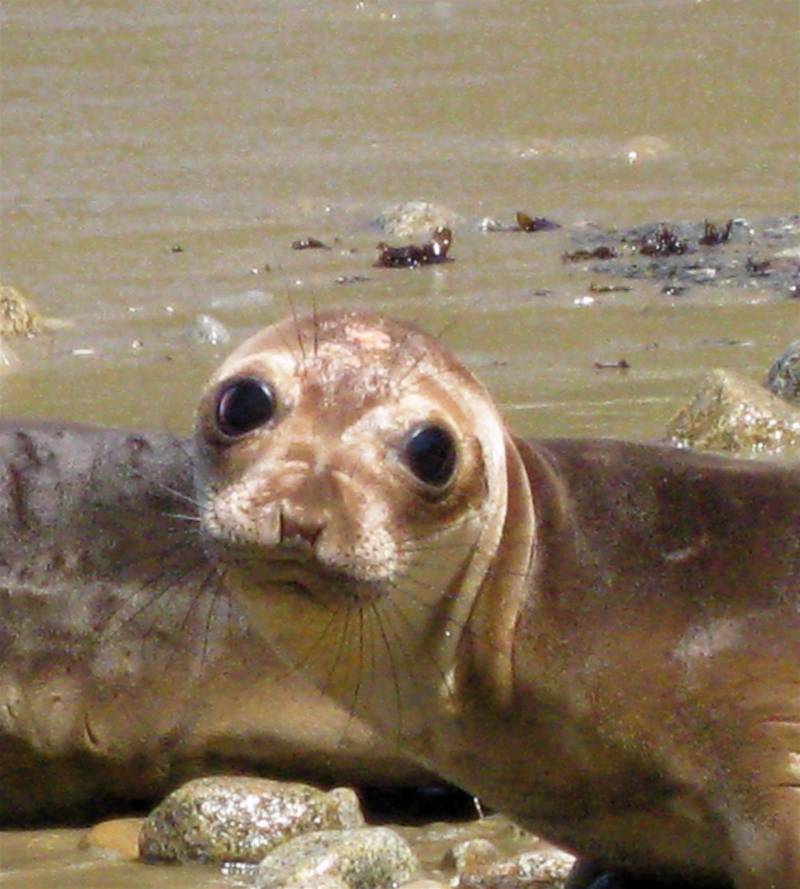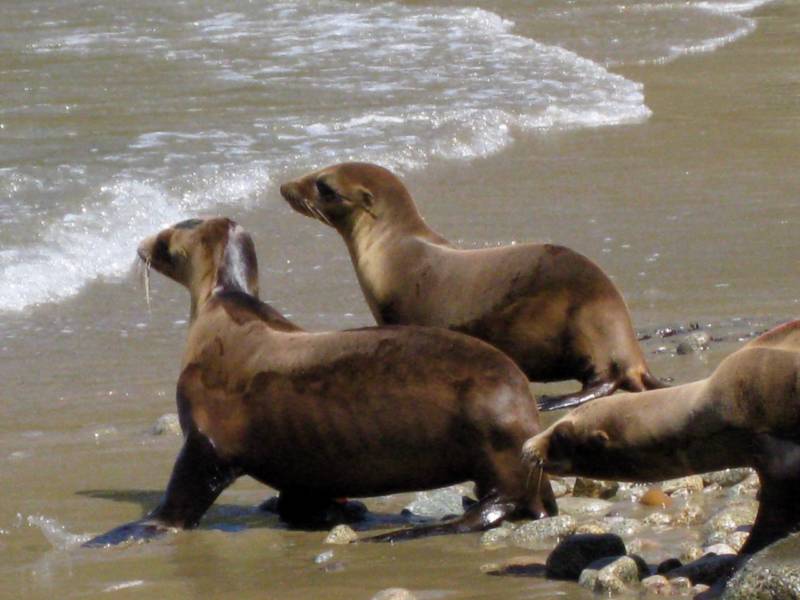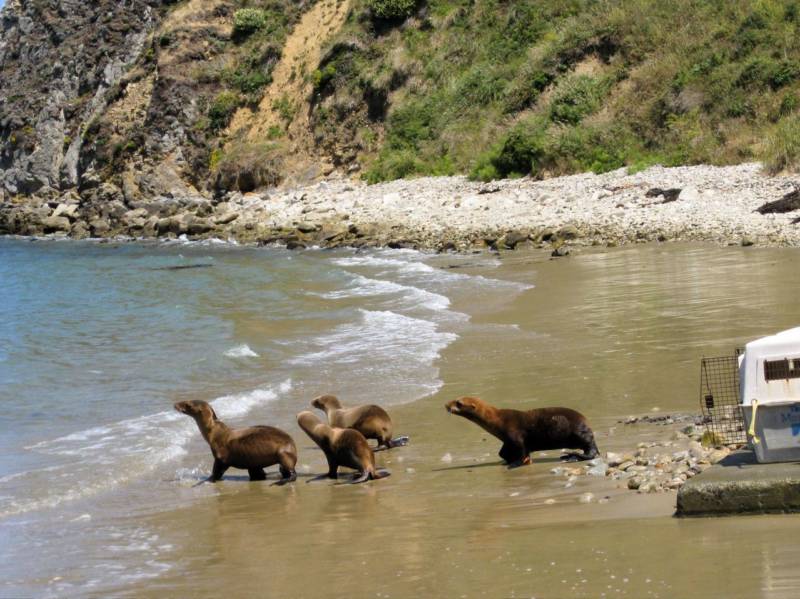
I thought the highlight of my trip to Point Reyes last week would be the cows grazing on spectacular cliffs covered with yellow lupine. I was visiting a historic dairy there for an upcoming story on crashing milk prices.
But then I noticed a white van marked “rescue” driving down to a dock near the Pt. Reyes lighthouse, and decided to follow it. Turns out, I stumbled upon an incredible scene: rescue workers releasing baby sea lions and elephant seal pups back into the waves.
Volunteers lugged what looked like over-sized pet carriers out of the van and slid them onto a cement boat dock. Then a trio of sea lion pups poked their heads out, sniffed the salt air, and flippered their way across the cement and into the water, playfully nuzzling each other.
They seemed exhilarated–but thin. These pups had been rescued near Monterey, revived in the Marine Mammal Center’s Sausalito hospital, and were now healthy enough to return to the ocean, though you could still see their rib cages poking through their fur.
The sea lions swam out quickly but the elephant seals were a little more sluggish. One pup kept swimming back toward the humans, begging for fish. Then a giant female came out of the waves, perhaps offering herself as an adoptive mom, nudging the baby into the water.
Jim Oswald of the Marine Mammal Center (MMC) says the staff is seeing an unprecedented spike in rescue calls. In just the first two weeks of June, nearly 1,300 people phoned in, worried about stranded sea lions and other mammals. Most of them are malnourished sea lions who can’t seem to find enough anchovies, herring, or sardines to snack on.

Researchers aren’t quite sure why–but haven’t ruled out some kind of climate connection. The MMC is reporting its findings to the National Oceanic and Atmospheric Administration (NOAA) to try and figure out the cause. Possible El Nino Conditions? Warming oceans sending schools of smaller fish northwards? No one quite knows at this point.
“If it’s a climate change variable, that’s going to affect the fish the animals feed on,” says NOAA Wildlife Biologist Joe Cordaro. “That could be a very long temporary shift in the bait fish distribution, or it could be long-term depending on how severely climate change affects the surface temperature of the ocean.”
But Cordaro says at this point, the sea lion strandings are “one big puzzle,” with climate change as just one possible factor. We could simply be witnessing a high-birth year for sea lions, with a lot more pups than usual, or early signs of a returning El Nino weather pattern. Meteorologists won’t know until the fall whether California actually meets the criteria for a strong El Nino year. If so, Cordaro predicts “things are going to get a lot worse for the sea lions this fall and next spring.”
[Editor’s Note: The case for a return to El Nino was advanced on Wednesday, when the Australian Bureau of Meteorology reported that indications are almost certain at this point]
Regardless of the cause, the MMC’s Oswald says it’s cause for concern.
“These young sea lion pups get to the point where they’re so weak, they end up on the land and they’re too weak to go back,” Oswald explains. “It’s easier for them to waddle along, hoping they’ll find another waterway where they can find some food. They’re using up all their reserves if they stay out in the ocean.”
Stranded sea lion pups have even turned up on Bay Area freeways. Last week, rescuers found one on the 880 freeway in Oakland.
“His name is Fruitvale,” reports Oswald, “for the district in Oakland he was rescued from. He seems to be doing okay. He’s still being tube fed. I’m told from veterinarians that he’s feisty, moving around, and nippy, which is a good sign.”
The Marine Mammal Center’s Sausalito headquarters lets visitors watch volunteers in action. There’s an interactive exhibit with a sea lion on a gurney, where you can see its x-rays and test results. You can watch volunteers prepare fish meal, or even witness a post-mortem in the necropsy room.
Sounds grim, but until sea lion pups start finding more fish to eat–and humans start to figure out what’s causing the food chain to collapse, the Marine Mammal Rescue Squad plans on a very busy summer.

Sasha Khokha is chief of KQED’s Central Valley Bureau and a frequent contributor to Climate Watch.
And for more about the Marine Mammal Center’s sea lion rescue efforts, listen to Amy Standen’s recent radio report on KQED’s Quest. You can also view her slideshow and read her Reporter’s Notes on the Quest blog.
3 thoughts on “Starving Sea Lions: A Climate Connection?”
Comments are closed.

http://www.mercurynews.com/centralcoast/ci_12767881?nclick_check=1
It seems that over-fishing is killing off all the fish that these animals (and cormorants) would otherwise have eaten. So maybe the climate is changing, but I was told at the Marine Mammal center that the el nino is still so far down south that it should not be impacting these animals yet. That means it’s something else. Could it be all those sardines being swept up in those nets? The link above seems to point that direction.
July 30, 2009
The United States Navy has been engaged in Naval Warfare Testing in their Northwest Training Range for many years. In the last few years they have expanded their Navy Warfare Testing Program in the Hawaiian Island, the Marianas Islands, Oregon, Washington, and Southern California.
Their expanded warfare testing in these areas of the Pacific Ocean could be negatively impacting all sea life and negatively impacting food chains and food supplies.
Now, in 2009, the United States Navy plans to hard 11.7 marine mammals (32 different species) in their proposal to expand their Navy Warfare Testing program in Washington, Oregon, Northern California, and Idaho. Their E.I.S. is located at: http://www.nwtrangecomplexeis.com and they are requesting that NOAA, National Marine Fisheries Service Approve this “taking” of marine mammals in the Pacific during warfare exercises.
See Federal Register – U.S. Department of Commerce March 11, 2009 Navy request permit to harm or kill 32 different species of marine mammals. This permit could be approved by the NMFS anytime this year and the Navy intends to beging this warfare testing expansion in September 2009.
Instead of blaming global warming for our starving sea lions and birds we should be look at the U.S. Navy programs as a possible culprit and we should ask for U.S. Congressional Hearings on this topic.
In addition, the United States Navy, according to Congressman Waxman is now practicing Navy Warfare programs in the Atlantic, the Pacific and the Gulf of Mexico. What will be the impact of increasing their testing range in the Pacific on Marine Life?
Respectfully,
Ava Peterson
Agriculture Defense Coalition
E-Mail: info@californiaskywatch.com